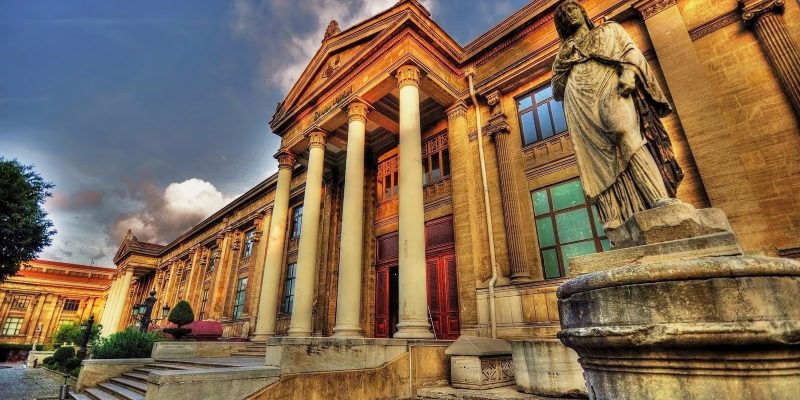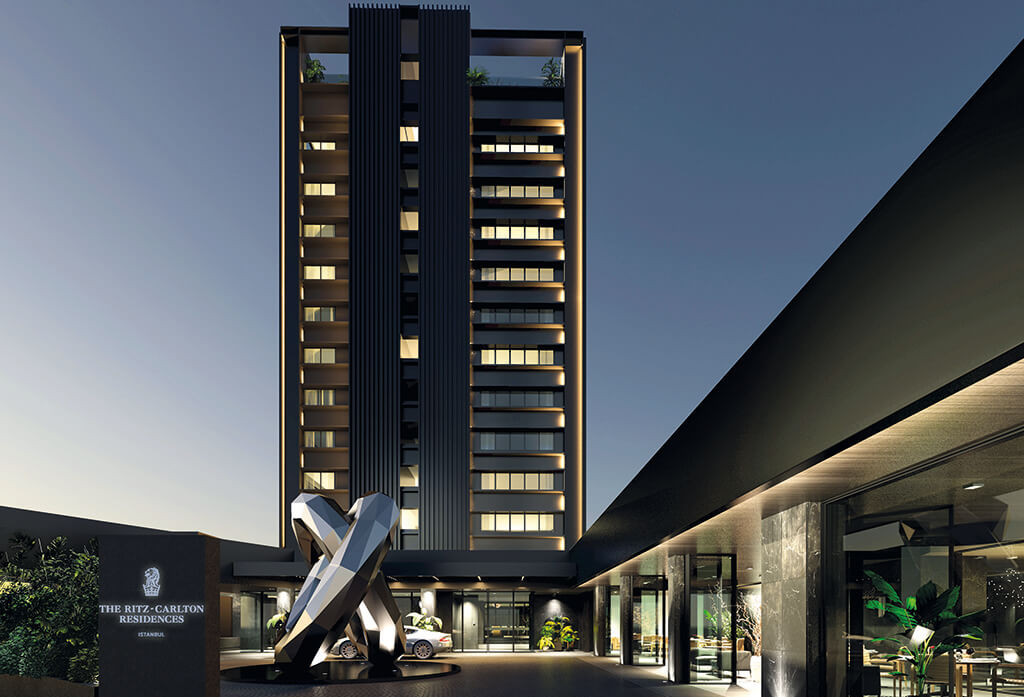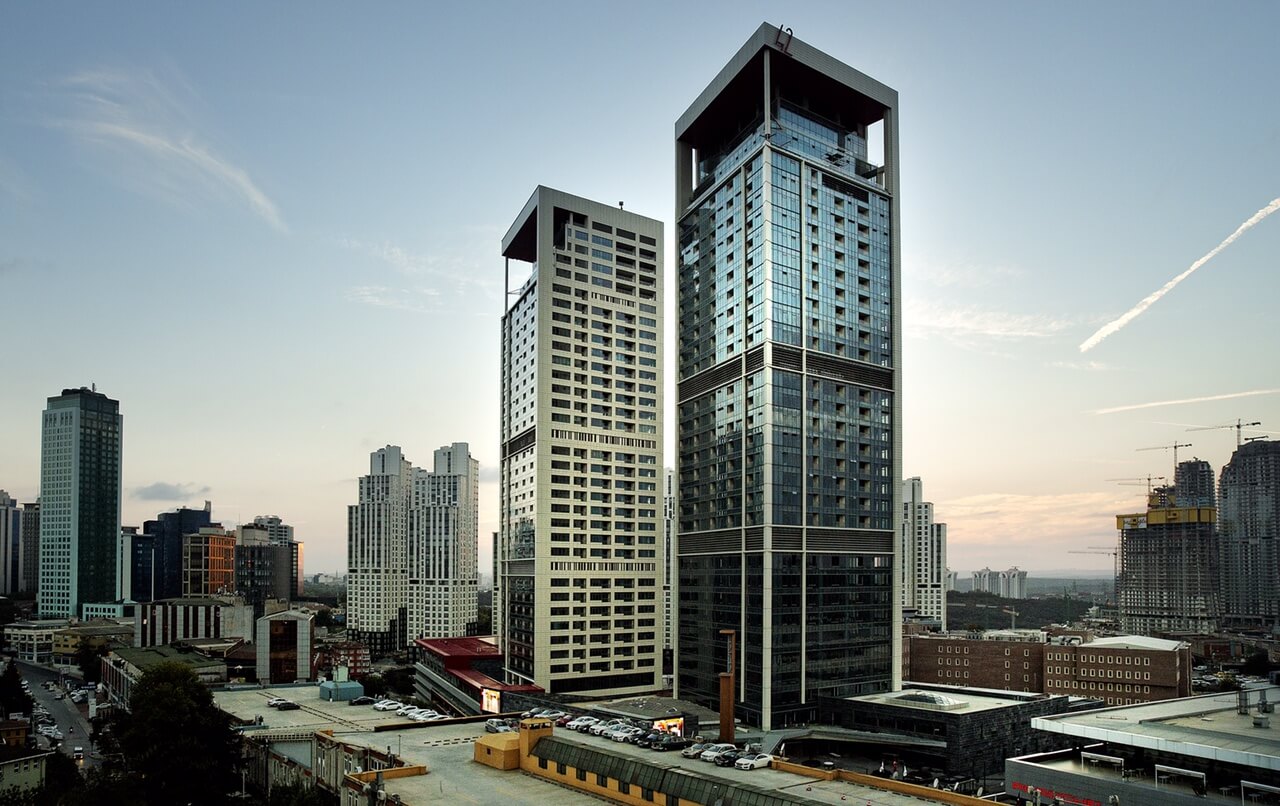This list of Museums of Istanbul and monuments in Istanbul, Turkey, includes the relevant architectural entities within Istanbul's city limits. Castles and palaces.
Archaeological Museum
This complex was build by the end of 19th century by the architect Vallaury thanks to great efforts of famous Turkish painter Osman Hamdi Bey. It includes the exquisite Tiled Kiosk and the Museum of the Ancient Orient and houses a large collection of artifacts and works of art belonging to ancient Greek, Roman and other Anatolian civilizations dating back to the 6th century BC. The Sarcophagus of Alexander the Great, Sarcophagus of Mourning Ladies, and other ancient sarcophagi and various objects found in the Sidon excavation are among its most interesting pieces.
Ancient Eastern Archeological Museum was designed and open to service in 1917 by Halil Eldem Bey. The collection on displays comprised of about 15000 archeological pieces of Ancient Mesopotamia, Pre-Greek Anatolia, Assyrian, Sumerian, Acadian, Babylonian, Ancient Egyptian and Pre-Islamic Arabic culture.
Open daily between 09:30-16:30 except Mondays.
Asiyan Museum
This museum is the former residence of famous Turkish poet Tevfik Fikret (1867-1915) who constructed the building himself. In addition to an exhibit of the personal belongings ofFikret, there is a room devoted to the poet Nigar Hanim and displaying some of the belongings of Abdulhak Hamit.
It’s located in Asiyan-Bebek district on the Bosphorus.
Open daily between 09:00-16:00 except Sundays and Mondays.
Calligraphy Museum
The Beyazid Medresse, which was used as the municipality library since 1945 was evacuated, restored and reorganized as the Turkish Calligraphic Arts Museum. It has interesting and valuable examples of the Turkish art of the pen, Korans, imperial seals, diplomas, Hilye-i serif (descriptions of the Prophet), equipment and apparatus for calligraphic writing, samples of bookbinding, holy relics and miniatures, especially from Ottoman and Seljuk periods.
Open daily between 09:00-16:00 except Sundays and Mondays.
Sadberk Hanim Museum
Founded by the Vehbi Koc Foundation in 1980 in the historical Azaryan residence along the Bosphorus, this museum is a beautiful three-story “yali” (old Ottoman house) and houses a rich collection of Anatolian-based works of art, antiques and relics dating from 6000 BC. It is the first private museum of Turkey opened by Koc family, the richest of Turkey.
Open daily between 10:00-17:00 except Wednesdays.
Modern Arts Museum
Opened its doors in December 2004 thanks to Eczacibasi family, this is the first and only Modern Arts museum in Istanbul. It’s housed at renovated old docks in Karaköy district facing Topkapi Palace, with a rich library, exhibitions, photograph gallery, sculpture courtyard, movie theater, cafe and souvenir shop. One can find in this private museum almost everything on modern Turkish Arts.
Open daily between 10:00-18:00 except Mondays.
Museum of Painting and Sculpture
Fine collection of 19th and 20th century Turkish painting and sculpture.
Caricature Museum
This museum was opened in 1975 in Tepebasi by the Istanbul Municipality through the efforts of the Caricaturists Association, then temporarily closed down in 1980 as the building where it was housed was torn down and later re-opened in its new site in Fatih district.
The Gazanfer Aga complex, which consists of an Ottoman medrese, a shrine and a fountain in Sarachanebasi, was restored for use as the new structure. Re-opened in 1989, the museum contains a rich collection of satirical works, written or drawn, and the exhibits are frequently changed.
Carpet and Kilim Museum
This museum is located in the Hunkar Kasri (royal residence), which stands north of the Sultanahmet mosque (known as Blue Mosque) complex. Hunkar Kasri was the place where the Sultan used to rest before he would join the prayer in the mosque. The museums has unique pieces of old Ottoman rugs and kilims.
City Museum
The museum was first located in the Bayezit Municipal Library from the year 1939 until it was moved to the Fine Arts building of the Yildiz Palace complex in 1988. On display are paintings depicting the social life of the Ottoman period in Istanbul, calligraphy, textiles, 18th and 19th century porcelains made in the imperial workshops of Yildiz Palace, various glass objects, calligraphy equipment and other objects of daily life.
Press Museum
A building on the Yeniceri (Janissary) Street in Cemberlitas district, originally built as a university by Safvet Pasha and having served different purposes from then on, now houses the Press Museum. Its architect is believed to be Fossati. The museum displays documents on the history of the Turkish press and old printing machinery.
Divan Literature Museum
The first dervish lodge in the city was built in 1492 and belongs to the Mevlevi order founded by Mevlana. The present wooden structure on the site dates from the late 18th century. It is situated in a large garden that includes a cemetery in the Tunel district of Pera. Historical objects and literature of the order are displayed.
Tanzimat Museum
19th century documents and objects belonging to the Ottoman Tanzimat period are displayed in this museum. It was first opened in the Ihlamur Mansion in 1952 and moved to its present location in Gulhane Park just below Topkapi Palace in 1983.
Museum of Turkish & Islamic Art (Ibrahim Pasa Palace)
Fine collection of art and ethnography in the lovely setting of Ibrahim Pasa Palace in the old Hippodrome area. It was built in the 16th century and donated to Grand Vizier Ibrahim Pasha by the great sultan Suleyman the Magnificent. He was the first counselor of the Sultan and married Suleyman’s sister as the sultan ascended the throne, thus occupying a very important place in the Ottoman palace hierarchy. After Ibrahim’s death the palace was used as a military barracks for new recruits, and made a museum during the Republic.
Open daily between 09:30-17:00 except Mondays.
Important note: The museum will be closed for restorations between October 2012 – April 2014 !!
Islamic Sciences & Technology History Museum
One of the newest museums of Istanbul opened by the Metropolitan Municipality in May 2008 at Gulhane Park, near Topkapi Palace. There are plans, copies and replicas of several inventions of Muslim scientists and researches throughout the history of Islam, especially between 8th and 16th centuries AD.
Open daily between 09:00-16:30 except Tuesdays.
Santral istanbul Energy & Arts Museum
The building used to be an electric power plant built by Hungarians in 1914 at the tip of the Golden Horn, and known as Silahtaraga Electric Plant. It produced energy for Istanbul from Ottoman period until 1983 then it was shut down because it wasn’t effective anymore to compete with modern technology. The grounds were taken by Istanbul Bilgi University in 2004 and converted into a university campus, restoring the power plant as well. Santralistanbul was opened as an electric museum displaying industrial power machines and for modern art exhibitions in September 2007.
Open daily between 10:00-22:00 except Mondays.
Bahcesehir College Science Museum
One of the newest museums of Istanbul opened in June 2008 inside the Bahcesehir private highschool. The museum has several tools and work stations aiming young children to explore the scientific world. Young visitors can test and learn several facts of science and physics at the interactive stations and research labs. There is also a Planetarium, sky observation station, and a 3-D movie theater for scientific educational films.
Open daily between 10:00-16:00 except weekends.
Rahmi Koc Industrial Museum
This museum is located in the anchor casting workshop at the docks on the Golden Horn (Halic in Turkish), an area that symbolized industrialization in the Ottoman Empire of the 19th century. The anchor casting workshop was built in the era of Ahmet II (1703-1730) and the building’s foundations go back to a 12th century Byzantine construction. It was restored under Selim III and used by the Finance Ministry until 1951. After a fire in 1984, the building stood in ruins. In 1991, it was bought by the Rahmi Koc Museum and Cultural Foundation, restored and opened to the public in 1994.
On the first floor, motors and steam engines are displayed. On the second floor are the scientific instruments and communications apparatuses. The entrance is reserved for the aircraft department, mint machinery for printing paper money and coins, bicycles and motorcycles, the naval department and ship engines. In the open area, there is a coast guard life-boat, a tram, a narrow gauge steam train, and a vertical steam boiler. There is a submarine in the water.
Open daily between 10:00-17:00 except Mondays.
Sakip Sabanci Museum
The building today known as the Horse Mansion on the Bosphorus was built in the 19th century and belonged to Sabanci family for many years. Just before the death of Sakip Sabanci the mansion was converted into a museum and opened to the public with its antique furnishings and art collections. Today the Museum’s collection of precious manuscripts and extensive collection of 19th and 20th century paintings are on permanent exhibition in the rooms of the original house and gallery annex. From time to time, it is also hosting great exhibitions of international artists such as Pablo Picasso, Rodin etc.
Open daily between 10:00-18:00 except Mondays.
Pera Museum
The museum was opened in July 2005 by the Suna-Inan Kirac Foundation, another project of Koc family. The old building was originally constructed in 1893 by architect Achille Manousos and restored recently for the modern museum. Kutahya tiles, Anatolian weights and measurements, and Oriental portraits painting Collections are the permanent exhibitions in the museum. One of the most famous paintings in the museum is of Osman Hamdi’s “The Tortoise Trainer” (Kaplumbaga Terbiyecisi in Turkish). In addition, three art galleries and an auditorium are among the facilities of the museum.
Open daily between 12:00-18:00 except Mondays.
Borusan Contemporary Museum
The museum is opened in 2011 at the headquarters of Borusan Holding, one of the leading companies in Turkey, located in a historic building in Rumelihisar. It’s a comtemporary art museum with exhibitions and events in its galleries. The museum has a caffeteria and a panoramic terrace with breathtaking views of the Bosphorus.
Open between 10:00-20:00 on Saturdays & Sundays Only, except if the weekend falls on the first days of the religious holidays or on January 1.
Rezan Has Museum
This private museum is located inside the Kadir Has University in the Golden Horn, inside an old building which also contains some relics of a Byzantine cistern and Ottoman hamam. The museum displays paintings and documents belonging to important persons who draw the Golden Horn in the past centuries, objects from Anatolia, and so on.
Open daily between 09:00-18:00
Ottoman Bank Museum
It’s located in the former head office of the Ottoman Bank on Voyvoda Street in Karakoy district and operates under the aegis of the Garanti Bank sponsored Ottoman Bank Archive and Research Center. The museum, organized in and around the bank’s safe room, draws on a wealth of information from the bank’s archive to narrate the history of this institution, which operated as the Central Bank, bank of issue, and treasurer of the Ottoman Empire.
Open to the public during weekdays between 10:00-18:00.
Is Bank Museum
Opened in November 2007 at Eminonu district, it’s located on Bankacilar Street of Hobyar neighborhood. The museum is housed in an old building of one of the oldest banks of Turkey, Is Bank, founded by Ataturk. There is a big collection of many documents, photos, films and objects collected since the foundation of the Is Bank, showing the economic and cultural heritage of Turkey and its recent history.
Open to the public between 10:00-18:00 except on Mondays, holidays, and 1st of January.
Adam Mickiewicz Museum
Adam Mickiewicz, Polish romantic poet and playwright, was born in Zaosie in 1798. He was arrested by the Russian police in 1823 because of taking part in a semisecret group which protested Russian control of Poland, he was jailed and then exiled to Russia. After his release, he spent the rest of his life in Western Europe and in Turkey where he continued to write his poems. He died during a cholera epidemic in Istanbulin 1885. His body was first transported to Paris and than returned to Poland.
His house in Tarlabasi neighborhood near Beyoglu was converted into a museum in 1955 to commemorate 100th year of his death. Inside the museum, there are many documents and information about the poet and his works, photographs of Constantinople of that time, and documents of Polish Liberation struggle. There is also a symbolic grave of the poet in the basement of the building. The museum today is administered by the Turkish and Islamic Arts Museum.
Open daily between 09:00-16:00, except on Mondays.
Ismet Inonu Museum
Inönü was the second president of the Turkish Republic. The summer house on Heybeli Island was bought by him in 1934 and lately it is rennovated and opened as a museum in 2008. There are personal objects and books of Ismet Inönü, as well as some exhibitions. The admission is free.
Open from April to November between 10:00-18:00.
Huseyin Rahmi Gurpinar Museum
Rahmi Gürpinar was one of the early Republic period writers of Turkey. His house on Heybeli Island, where he lived between 1912-1944, has been rennovated and converted into a museum by the Ministry of Culture and volunteered school theachers in 1999. The house is located on a high hillside of the island, where one can visit his personal objects, books, and some handycrafts made by the writer.
Open daily between 10:00-16:00, except on Mondays.
Leyla Gencer Museum
Leyla Gencer was a world famous Turkish opera Diva and the Primadonna of the La Scala opera for 25 years while she lived in Italy. Interior of her house in Milan is reproduced inside the IKSV building in Sishane neighbourhood near Galata Tower, where you can see items and furnitures from the life of this great soprano such as her piano, her library, her photographs, her dining room and her bedroom.
Open daily between 11.00-16.30 on Wednesdays, Thursdays, Fridays and Saturdays.
Dogancay Museum
The Dogancay Museum, Turkey’s first modern art museum, was officially opened in 2004. It is centrally located in a 150-year old historic building in the bustling section of Beyoglu in walking distance from Taksim Square. The museum provides a general overview of a small portion of the prolific oeuvre of one of Turkey’s leading artists, Burhan Dogancay, and that of his father, Adil.
Open daily between 10:00-18:00
Museum of Innocence
The Museum of Innocence, inspired by the same name book of the Nobel Prize winner author Orhan Pamuk, was opened in 2012 in a historic building located in a residential area near Galata Tower. The belongings of Fusun collected by Kemal, the two characters of the book, are displayed on all three levels of the museum. These objects, which embody daily life in Istanbul during the second half of the 20th century, are well displayed in boxes and cabinets.
Open daily between 10:00-18:00, except on Mondays
Miniaturk
Miniaturk is also named as the “Showcase of Turkey”, where you can find many important structures of Turkey in small scales, models of architectural masterpieces representing the Anatolian and Ottomancivilizations.
Models of 105 historical and architectural works, all made in the scale of 1/25, including the Library of Celsus at Ephesus, the Malabadi Bridge in Diyarbakir, Grand Mosque of Bursa, the Tomb of Mevlana in Konya, Dome of the Rock (Mescid-i Aksa), the Church of St. Antoine in Istanbul, the Ottoman galley, Savarona (Ataturk’s boat), the Underground Cistern (Yerebatan), Stone houses of Mardin, Fairy chimneys ofCappadocia, Ataturk’s Mausoleum in Ankara, Aspendos theater in Antalya, Hagia Sophia and the Maiden’s Tower of Istanbul, can all be seen in one single place. There is also a miniature railway network, a motorway with moving vehicles, an airport with moving airplanes, thousands of human figures, and ships sailing across the Bosphorus. These dynamic models make Miniaturk a living park.
Built in 2003 on a 60,000-square-meter site in the Golden Horn, it is the largest miniature city in the world and has attracted lots of interest and is located opposite the Pierre Loti Coffee House in Eyup district, a favorite with tourists.
Open daily between 09:00-17:00
Toy Museum
This is a private museum founded by Mr. Sunay Akin in a historical residence that belongs to his family, in Goztepe district of Istanbul. Approximately 2000 toys and miniatures are exhibited in the museum that occupies 500 square meters of land. Sunay Akin has collected some 4000 toys from Turkey and abroad. The oldest is a miniature violin manufactured in 1817 in France. A doll made in 1820 in United States, marbles from United States dating back to 1860 and German toys made from tin, and porcelain dolls are other items of the extensive collection.
The museum has a cafeteria and a very small theater as well.
Open daily between 09:30-18:00 except Mondays.
Wax Museum
A private museum opened in 2012 in the modern Sapphire shopping mall located in a residential area of Istanbul. The wax statues were made by Mrs. Jale Kushan, using very realistic materials and the wax. There are around 60 wax statues of many important figures such as Attila, Elvis Presley, Da Vinci, Karl Marx, Mevlana, Ataturk, Napoleon, Beatles, and many other historic and live personalities around the world.
Open daily between 10:00-22:00
SAV Automobile Museum
The Sabri Artam Vakfi Antique Automotive museum has the largest collection of antique cars in Turkey with its over 100 vehicles collected privately in a record time frame of 15-20 years by Artam family. The museum is recognized by FIVA (Federation Internationale des Vehicule Anciens – International Federation of Antique Vehicles) as well. There are many special cars in the collection from last century, such as 1907 model Panhard-Levassor, 1912 model Mercer, 1926 model Bugatti, and 1929 model Packard. There is also the largest collection of Ferrari’s in Turkey, and special models of Maserati, Lancia, Alfa Romeo, Lamborghini and Fiat cars are on display.
The museum is located in Cengelkoy, near Uskudar on the Asian side of Istanbul, and has a total of 5 floors; in the basement there are cars produced after 1960’s, on the second floor cars from 1950’s, on the third floor a cafeteria and antique cars, and on the roof there are model cars.
Open daily except weekends and holidays, between 08:30-12:30 and 13:30-17:30
Museum of the Princes’ Islands
The Museum of the Princes’ Islands is a contemporary city museum of Istanbul opened in 2010 at Buyukada, one of the Princes’ Islands. The museum tells the story of the Islands from the geological formation of them to the present day, displaying hundreds of objects, Ottoman archival documents, photographs, documentary films, and so on.
Open daily between 09:00-18:00, except on Mondays
Panorama 1453 History Museum
One of the newest sights of Istanbul and the first and the only panoramic museum in Turkey, describing the Conquest of Constantinople in 1453 with 3-D objects and paintings, including sounds too. The museum is located in front of the ancient city walls of Edirnekapi where the Janissaries were first able to breach the city during the siege. Inside the museum you can have a 360 degrees of vision when you look at the wall paintings from a distance giving you a 3 dimensional impression. This 3-D effect makes you think that the picture is without boundaries.
Open daily between 09:00-17:00
Military Museum
The museum consists of many interesting military pieces such as uniforms belonging to every period of Ottoman army, various weapons from bow and arrow to triggered guns, seals, armors, tent of the sultan,sultan swords, flags, photos of ministers of defense, Byzantine Cavalry Flag, various warfare pieces used from the Seljuk period to the Republic period, and the chain with which Byzantines closed the Golden Hornbefore the Conquest. There is also a Janissary Band show daily between 3-4 pm, if they’re not on a tour.
Open daily between 09:00-17:00 except Mondays and Tuesdays.
Naval Museum
The museum was opened to public m 1960. It displays the uniforms of the Turkish sailors, models of Turkish naval vessels, and paintings, engravings and maps related to Turkish maritime history. Also the materials and souvenirs from the vessels used in the first years of Ottoman Empire and the Republic, pictures of some navy disasters and martyrs, wartime weapons such as hand-bombs, torpedo, fire gun and sketches of several fleet commanders are amongst the display. Sultans’ row-boats (Saltanat Kayigi in Turkish) are on display on its lower floor. In the courtyard of the museum, cannonballs of various sizes and a part of German Battleship which sunk in our coastline during Second World War are also displayed.
Open daily between 09:00-17:00 except Monday and Tuesdays.
Aviation Museum
The museum stands within the Air Command Headquarters of Istanbul and has both indoor and outdoor exhibition sections; jet-motor and hovercrafts, cargo planes, helicopters, some aviation arms, pictures, emblems, medallions and belongings of Turkish air pilots are displayed. The Museum also features movie theater, conference room and a cafeteria.
Open daily between 09:30-16:30 except Monday and Tuesdays.
Fire Brigade Museum
This museum presents a chronological history of fire fighting in Istanbul starting with the water pumpers (tulumbaci in Turkish) of Ottoman times. All kinds of fire brigade equipment, from the first motorized fire engines to firemen’s clothing and tools, are displayed. The museum in its present building opened in 1992 within the main Fire Brigade headquarters in Fatih district, after many years of collecting and repairing the objects.
Open daily between 09:00-17:00 except Sundays and Mondays.
Kariye Museum Church of St. Saviour in Chora
Ancient Byzantine church later converted into a mosque in the 15th century AD. It is now a museum of Byzantine mosaics and frescoes. The typical Ottoman neighborhood with wooden houses is also very interesting to stroll around.
Open daily between 09:30-16:30 except Wednesdays.
Yerebatan Sarayi (Cistern Basilica)
Byzantine cistern from the 6th century built by Justinian I and is located to the south-west of Hagia Sophia. The water was brought from Belgrade Forest, 19 kilometers to the north ofIstanbul, and it had a capacity to store 100.000 tons of water. It features fine brick vaulting supported by 336 various type of columns brought here from different parts of the Empire. The Basilica Cistern, or Underground (Yerebatan) Cistern as locals call it, now houses a cafeteria and hosts musical and theatrical performances and a Biannual. There are also two Medusafriezes brought from the Temple of Apollo in Didyma (today’s Didim). Its dimensions are 140x70x9 meters.
Open daily between 09:00-18:30
Binbirdirek Cistern (Binbirdirek Sarnici)
It’s one of the oldest Byzantine cisterns of Istanbul; it was built by Philoxenus to the west of the Hippodrome as a huge water storage in the 4th century AD during the reign of Constantine the Great. The dimensions of the cistern are 64 x 56 meters with 15 meters of height and there were 224 original columns, out of which 212 of them survived until our days. The brick arches and the roof surrounded by tick walls are supported by these columns. Binbirdirek in Turkish means “Thousand and one columns”, referring probably to its many columns. During the Ottoman period it was used as a silk threads production atelier and unfortunately as a dump during the Republic period. It was opened to the public in 2002 after a long restoration period. Besides being a museum, today there are small shops, a restaurant and a cafeteria in the middle, the cistern is also used for special meetings during incentives and for small scale music concerts.
Open daily between 09:00-18:30
Camlica Hill
Situated on the Asian side of Istanbul, this 262 m. hill provides a panoramic view of the city and has nice cafeterias to enjoy Turkish tea or coffee. It is also a well known spot for watching migrating birds over theBosphorus.
Open every day.
Sultanahmet Square (Hippodrome)
Scene of horse and chariot races and the center of Byzantine civic life. It was the place where the Nika Riot started in 532 AD. There are an Egyptian Obelisk, a stone obelisk and the Serpentine Columnwhich were originally brought by the emperors and used for the decoration of the Hippodrome. At the other side of the Hippodrome the German Fountains still functions today. The imperial lodge was located to the west of the Hippodrome where Ibrahim Pasha Palace stands now. Today Sultanahmet Square is a nice area for picnics and meetings.
Open everyday.
Kapalicarsi (Grand Bazaar)
Built in the 15th century as a complex of 3,000 shops selling raw materials to be used in clothes manufacturing, the Covered Bazaar fulfills a viable commercial function to this day. The Bazaar’s fine shops and exotic atmosphere, mingling the ancient and new, make it a “must-see” in Istanbul. It’s divided into many sections such as leather, rugs, souvenirs, copper, antiques, textile etc. There are 18 gates and 60 streets inside. Click here for more information on the Grand Bazaar.
Open everyday except Sundays and National Holidays.
Misir Carsisi (The Egyptian Spice Bazaar)
Built in the 17th century next to the Golden Horn, the Spice Bazaar is the second largest covered bazaar in Istanbul. Originally housing shops selling medicine and spices, the Spice Bazaar continues to fulfill its original function. This distinguished example of Ottoman architecture continues to sparkle with life even today. Click here for more information on the Spice Market.
Open everyday except Sundays and National Holidays.
There are many other museums in Istanbul like; Anadolu Fortress, Beylerbeyi Palace, Dolmabahce Palace, museum of the Ancient Orient, Rumeli Fortress, Yildiz Chalet, Tekfur Palace, Ataturk’s Sea Mansion in Florya, Sait Faik Abasiyanik museum at Darussafaka, Burgazada museum on Princes’ Islands, Hilmi Nakipoglu Photo Cameras museum in Bakirkoy neighbourhood, Ercumend Kalmik museum in Gumussuyu neighbourhood, Sea and Sea Products museum in Beykoz district, and so on.









